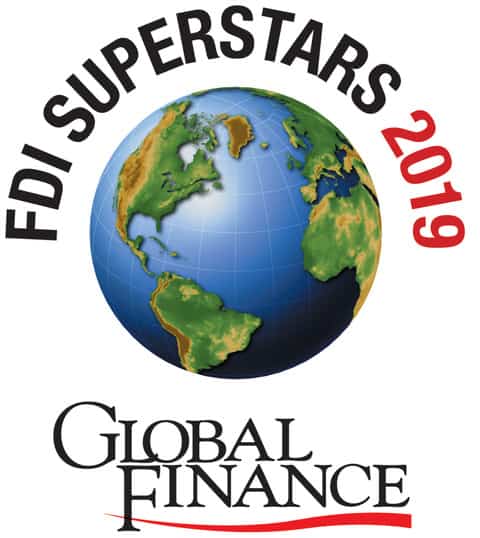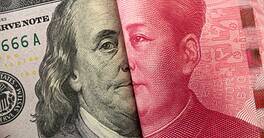Trump’s tax reform, tariff wars and Brexit put a brake on Western FDI and shifted flows to developing countries.

Tariff tensions, US policy and Brexit are roiling the waters of world trade, shifting global investment flows. Worldwide foreign direct investment (FDI) shrank for a third year running, by 13% year-on-year, bringing total FDI down to $1.3 trillion. This past year’s contraction was largely driven by the repatriation of foreign earnings by US companies in the aftermath of the American Tax Cuts and Jobs Act approval in December 2017, although China’s shrinking outward flows and Brexit uncertainty didn’t help.
According to the United Nations Conference on Trade and Development (UNCTAD), developed countries as a whole pulled in 25% less in FDI. With dark clouds of Brexit looming, investment into Europe fell the most, by 55%, to a 15-year low. Europe’s transition economies (Southeast Europe, the Commonwealth of Independent States and Georgia) saw inbound FDI fall 28%. The Americas suffered more moderate declines, with a drop of 9% in the US and 6% in Latin America and the Caribbean. Yet it wasn’t all doom and gloom: Developing Asia saw FDI rise 3.9%, while Africa’s FDI grew 11%, mostly in the south.
For the past few years, Global Finance has rated countries by how well they attract foreign investors. Ranking FDI attractiveness is no easy feat. We incorporate myriad factors: the quality of natural resources, including the labor force; the potential of the market; the strength and independence of institutions; and government policies and incentives. Further, we consider FDI relative to each country’s economic size, for insight into which smaller countries outperform. Finally, because FDI can fluctuate dramatically from year to year, the Global Finance FDI attractiveness algorithm incorporates a 10-year performance vector as well.
The list of countries that come out on top—the Global Finance FDI Superstars—shows both continuity and variability. This year’s list has seven countries moving up, two moving down, one holding steady and 10 countries that are new to Superstar status. Last year, the UK fell from first place right out of the top 20, largely due to Brexit. This year, Ireland, last year’s #2, and Switzerland, last year’s #4, also fell out of the top 20, in part due to US tax reform that sparked extensive repatriation of earnings. Ireland’s FDI went negative, with divestments reaching $66 billion.
Still, it wasn’t a bad year for FDI in Ireland. The Ernst & Young Annual European Attractiveness Survey identified a spike of 52% in the number of investment projects in 2018. BDO ranks Ireland as the fifth-most attractive destination in the world for foreign investors. And UNCTAD data shows a continued increase in the value of announced greenfield projects in the country, up by around 30% in each of the past three years and reaching close to $11 billion in 2018. Ireland may well be the most exposed to the potential consequences of Brexit, but it is also one of the main beneficiaries of the corporate exodus leaving the UK.
Ireland isn’t the only country getting a Brexit benefit. A Financial Times piece comparing greenfield projects in the three years before and three years after the referendum found that greenfield FDI increased in most countries except the UK, with countries Poland, Romania and Spain receiving the most.

“There has been a positive effect in the production of goods, and there are hints that some financial and consulting services may have been moving from London to Spain,” says Miguel Cardoso, chief economist for Spain at BBVA. Still, he cautions, “investment decisions to boost capacity have been delayed in sectors more exposed to external demand, like agrifood or automotive, especially in companies with a higher dependency on the UK market.”
With construction of new plants slowing, royalties, licensing fees and services represent a growing share of global capital flows. Corporations increasingly choose licensing deals or the sale of corporate services over equity ownership in their international relationships. In this landscape, the otherwise perfectly respectable use of intellectual-property licensing, together with a range of corporate tax-optimization strategies that have a less favorable reputation, have boosted what the IMF calls “phantom” FDI. These are investments that pass through special purpose entities (SPEs)—companies with no identifiable structure and no other goal than to channel capital into and out of a country—usually to avoid or reduce tax costs. Despite several international initiatives to curb the consequent tax-base erosion, IMF researchers estimate that the weight of phantom FDI has surged since 2009 from about 30% of global flows to almost 40%, or $15 trillion, in 2018.
Superstars: Countering Global Headwinds
This year’s FDI Superstars managed to post stable or growing inflows despite global headwinds. Resilience requires political and economic stability, solid investment protections and a business-friendly atmosphere. Some offer favorable tax and incentive programs to further entice investors. Talent is also an increasingly important asset.
#1 | SINGAPORE
Despite China’s slowdown and the global contraction of FDI, Singapore manages to maintain first place in our ranking, well ahead of the Netherlands at #2. Roughly half the size of London and with no natural resources to speak of, this global financial hub nevertheless competes with giants: It ranks fourth for total FDI, despite its size. The small Asian city-state has increased its GDP at an incredible pace since the 1980s, and now ranks 10th in GDP per capita, one position ahead of the US, according to IMF estimates for 2018. Singapore received $77.6 billion in FDI last year, a modest 2.5% increase from the previous year. It pulls in a share of FDI 15 times bigger than its share of world GDP.
Singapore benefits from its central position in the Asia-Pacific area, a stable pro-business institutional framework and a reputable education system. Although a favorable corporate-tax system is one of Singapore’s main enticements, according to corporate-services provider Hawksford, almost half of the multinational corporations based in Singapore have chosen to locate their headquarters there. US-China trade wars may accelerate the trend.
“Singapore is an excellent location for corporate regional headquarters because of the bilateral trade relationships we maintain with both China and the US,” says Irvin Seah, senior economist at DBS. “And while Singapore may not be competitive in terms of manufacturing costs, companies still prefer it for their regional headquarters because of our great logistic and financial connectivity.”
#2 | THE NETHERLANDS
The Netherlands bucked the global downtrend, increasing its FDI inflows by almost 20% to $69.7 billion. According to UNCTAD, Netherlands FDI figures got a boost from intracompany loans, which this year contributed $17 billion. The M&A scene brought $40.4 billion to the table, with the acquisition of Akzo Nobel’s chemicals unit by US investment firm Carlyle and Singapore’s sovereign fund GIC adding $12.5 billion.
As noted in a recent IMF Economic Brief, FDI to the Netherlands is partially due to multinational companies channeling investments through the Netherlands to avoid taxes. But low taxes clearly aren’t the only enticement of the Low Countries. Business-friendly institutions, excellent infrastructure and an educated, English-speaking workforce make the country an excellent destination for productive investment.
The Netherlands Foreign Investment Agency (NFIA) estimates that 100 companies have moved to the Netherlands from the UK over concerns about losing access to the EU’s single market. According to Invest in Holland, some 372 companies invested some $3.2 billion in the country in 2018 and brought in 9,847 new jobs. Sectors that attracted more projects in the past two years include information and communications technology (ICT), services, transport and logistics, and life sciences and health.
The flow of foreign investment seems likely to be sustained, given that the number of greenfield projects announced increased to 307 in 2018, from 235 in 2016, according to UNCTAD. The value of those greenfield projects rose 38% in 2018 to $14.1 billion, the highest increase in Western Europe.
#3 | AUSTRALIA
This economic powerhouse is on its 28th consecutive year of growth. Despite the global decline and stalling investment in its extractive industries, Australia saw an impressive 43% increase in FDI inflows in 2018, to $60.4 billion. According to UNCTAD, an increase in foreign investment income brought reinvested earnings up to $25 billion. M&A, with a net value over $33 billion, also carried important weight, especially in the financial and insurance sector, with $19 billion coming mostly from the sale of real estate investment trusts.
Last year, Australia established new measures to facilitate FDI, including creating a new online portal for project applications and raising the threshold of foreign ownership that requires government approval from 15% to 20%. Conversely, amid growing concern over Chinese influence, screening of foreign ownership in electricity infrastructure has been tightened and a new regulation requires that agricultural land be offered to domestic investors before it can be sold to foreign ones.
Australia offers an extremely solid economy, access to Asia-Pacific markets and an educated and culturally diverse English-speaking workforce, making it one of the preferred gateways to Asia, especially for American and British companies.
#4 | SPAIN
Spain enters the Superstars list this year at #4 after FDI inflows more than doubled, from $20.9 billion in 2017 to $43.6 in 2018. Some of the country’s enticements include excellent transportation networks, a restructured financial sector, a booming tourism sector, and cultural proximity and strong economic ties to Latin America.
BBVA’s Cardoso sees some shifts in FDI targets. “In recent years, changes in labor regulations brought a moderation of labor costs that helped significantly boost investment in the automotive sector, and tourism has also benefited from a lot of attention from foreign investors,” he says. “The novelty in the past year has been a growing interest in sectors more oriented to internal demand, like services and real estate.”
Spain’s spike in FDI inflows was mostly driven by M&A sales that UNCTAD estimates at $71 billion. The acquisition of Spanish highway operator Abertis by Italian Atlantia, Spanish ACS and German Hochtief alone drew in some $19 billion. Spain’s growth also spurred real estate deals: Blackstone acquired some assets of the old Banco Popular Español for $6 billion, and Cerberus signed a similar deal with BBVA for $4.7 billion. Cardoso expects M&A deals to continue: “The strong adjustment in the valuation of many Spanish companies and real estate assets after the crisis still offer high potential profitability.”
#5 | CZECH REPUBLIC (CZECHIA)
After a stark drop in 2015, FDI inflows to the Czech Republic recovered strongly in 2016 and have stayed mostly stable in the past three years. According to an Economic Brief from the European Commission, “almost one-third of all jobs in the Czech Republic are provided by multinational corporations (MNCs), more than in any other CEE country,” and the ratio of FDI to GDP has grown 600% since 1993. Czechia offers a stable environment, a skilled and relatively inexpensive workforce, good quality of life and a favorable location at the heart of Central Europe. The Czech government has strived to offer tax incentives and subsidies, especially in the manufacturing and technology sectors. In 2018, a new visa program was set up to award residency to non-EU citizens who invest a minimum of €1.9 billion ($2.1 billion).
The manufacturing sector, primarily autos and metallurgy, is a primary target of FDI; other sectors receiving significant FDI in recent years include financial services and wholesale and retail. The biggest M&A deals this year were in pharma and telecom, with the acquisition of generics producer Zentiva by private-equity firm Advent International for €1.9 billion, and Vodafone’s acquisition of Liberty Global systems for €1.4 billion.
#6 | UNITED ARAB EMIRATES
The United Arab Emirates jumped from #11 last year to #6 this year. A model for political and economic stability in the region, the UAE held steady in FDI as well, at just above $10 billion. Investment flowed to a range of sectors, from traditional oil and gas to digital technology. And Abu Dhabi is creating a special FDI unit that will work to win foreign investment and facilitate the licensing of FDI projects. The UAE’s Doing Business ranking has improved significantly, rising from 31 in 2016 to 11 in 2019. Although restrictions to ownership remain, the country recently approved a list of 122 business segments across 13 sectors that are eligible for 100% foreign ownership.
The UAE’s low energy costs, natural resources such as oil, strong purchasing power and diverse international workforce are key attractions for investors, in addition to almost nonexistent taxation on business and personal income, the absence of any limits on capital repatriation and a strong banking sector.
#7 | HUNGARY
Hungarian FDI inflows almost doubled in 2018, helping the country rise 74 positions in our ranking. After net divestment in 2015 and 2016, the country’s FDI has significantly recovered, although it’s still far from its 2012 record high. The Hungarian Investment Promotion Agency (HIPA) says 98 projects came to Hungary in 2018, backed with capital of more than €4.3 billion ($4.7 billion) and creating up to 17,000 jobs. With GDP picking up at good pace and the lowest corporate tax in Europe, at just 9%, Hungary has risen as a destination for FDI in Eastern Europe this year.
Hungary is among the countries that last year approved new screening procedures on certain strategic sectors, which could limit investment opportunities. On the other hand, the country has taken additional measures to reduce the corporate tax burden. In June 2019, a bill was approved that reduces the social-services contributions companies pay per employee to 17.5%. A two-point further reduction is expected next year.
#8 | MALAYSIA
The relative stability of Malaysia’s FDI flows amid a global contraction, a comfortable GDP growth rate, and excellent rankings in the Global Peace Index and Doing Business index helped launch Malaysia from #12 to #8 among our Superstars. Plus, the country seems to be benefiting from global trade tensions.
Although total FDI inflows have decreased, the Malaysian Investment Development Authority (MIDA) said the country’s approved FDI in 2018 had increased by 48% to $19.2 billion. Foreign investment in manufacturing surged by 169% to $13.9 billion, with China and Indonesia as the biggest contributors.
Government sources, referring to Malaysia as a “safe haven for international supply chains” partially attributed this increase to the US-China trade war. Chinese investments in the manufacturing sector soared, increasing by 411% to $4.7 billion, while US manufacturing investments grew by 185% to $770 million. According to MIDA’s figures for 2019, US investments are quickly accelerating, showing a 270% increase from last year. Malaysia is pushing to capture a bigger share of FDI, and in September approved streamlined procedures for the approval of foreign investments.
#9 | ISRAEL
Despite geopolitical tensions, Israel has managed to maintain strong GDP growth in the past decade. It climbs from #17 last year. Despite the global decline in FDI and after a record increase in 2017, Israel’s FDI inflows grew by 20%, reaching an all-time high of $21.8 billion. According to PwC, M&A deals had a lot to do with it, increasing in value by 77% to $21.6 billion in 2018.
Israel has also earned a reputation as a hot spot for start-ups and an excellent location for R&D. It has the highest ratios of R&D spending among OECD (Organisation for Economic Co-operation and Development) countries.
While the US remains the main source of FDI, Chinese investors are showing increased interest. According to OECD, China’s FDI in Israel increased by 48% between 2016 and 2017. According to fDi Intelligence, both greenfield projects and venture capital investments from China are on the rise. Yet, stronger ties between Israel and China and the Chinese takeover of Haifa’s port have raised security concerns in the US and put pressure on Israel to screen investments in strategic sectors.
#10 | CANADA
Canada vaults into the top ten from #55, as FDI inflows rose by a spectacular 50.6% to $39.6 billion in 2018. Canadian FDI dipped in the prior two years due to falling oil prices and uncertainty around the North American Free Trade Agreement, with 2017 showing the lowest figures since 2009. According to UNCTAD, divestments in the oil and gas industry in 2017 were worth $25 billion, but this drain stopped in 2018.
Canada offers a well-qualified workforce, business-friendly environment and important reserves of oil, gas and ore. With a marginal effective tax rate of 13.8%, it also offers the lowest business tax costs among G7 countries. Although FDI inflows in 2018 are still far from the country’s historic high in 2013, authorities are optimistic. Canada is reducing its dependency on oil and gas—and also its dependency on US investors, with an increase of more than 300% in non-US FDI in 2018. With Toronto and Vancouver recruiting tech workers at a faster pace than San Francisco and Seattle, Canada may well have shifted from losing talent to other countries to winning it. The Canadian government’s commitment to strengthening FDI was reinforced in November 2018, with the approval of a package of C$14 billion ($10.5 billion) in write-offs for capital investments.
#11—#20
Panama, with its strategic infrastructure and corporate-friendly regulations, rises a few spots after a year of record M&A deals that boosted its FDI flows by 21%. Hong Kong’s financial and trade hub follows, although this year’s protests will doubtless impact next year’s results. Despite losing some steam, Portugal showed significant improvement in the past decade. Oman makes #14 after an excellent year in greenfield investments, driven by the creation of the Duqm Special Economic Zone. In Slovenia, after a slump in 2017, privatizations and takeovers in the manufacturing and financial sectors generated an 81% increase in FDI. Vietnam has seen a decade of consistent FDI growth, and has recently been attracting increased Chinese and US manufacturing investment.
An improved business climate brought a wealth of greenfield projects that helped Serbia rise to #17 from #20 last year. After significant improvement in its Ease of Doing Business score and with very low corporate and personal income tax rates, North Macedonia, at #18, more than tripled its FDI flows last year. Declining after a peak in 2011, Latvia’s FDI inflows have significantly improved in the past two years, raising its stance in our ranking to #19. Rounding out our ranking is Indonesia, showcasing an outstanding recovery since 2009 with increased investments from Singapore, China and Japan, and confirming the South Asian region as one of the world’s most resilient in times of dwindling global FDI.
The Global Finance FDI rankings show that there is more than one path to the finish line in the race for development dollars. Whether by bolstering education or loosening regulations, strengthening infrastructure or opening access to natural resources, countries around the world are striving to attract the funds to take them to their next stage of development.
|
2018 Rank |
2019 Rank |
Country |
Total Score |
| 1 | 1 | Singapore | 181 |
| 3 | 2 | Netherlands | 258 |
| 9 | 3 | Australia | 265 |
| – | 4 | Spain | 270 |
| – | 5 | Czechia | 286 |
| – | 6 | United Arab Emirates | 325 |
| – | 7 | Hungary | 330 |
| 12 | 8 | Malaysia | 344 |
| – | 9 | Israel | 347 |
| – | 10 | Canada | 357 |
| 14 | 11 | Panama | 357 |
| 8 | 12 | China, Hong Kong SAR | 361 |
| 5 | 13 | Portugal | 374 |
| – | 14 | Oman | 395 |
| – | 15 | Slovenia | 397 |
| 25 | 16 | Vietnam | 409 |
| – | 17 | Serbia | 417 |
| – | 18 | TFYR of Macedonia | 429 |
| – | 19 | Latvia | 450 |
| – | 20 | Indonesia | 433 |
| – | 21 | Argentina | 452 |
| 24 | 22 | Brazil | 466 |
| – | 23 | Mongolia | 471 |
| – | 24 | Bahrain | 476 |
| – | 25 | Lao People’s Dem. Rep. | 480 |
Rising Stars
Our rising stars aren’t great economic powers, but have shown the greatest improvement over the past ten years. This list shows the most instability, because for small economies, a single project can mean huge relative change despite the stabilizing effect of the 10-year window. The shifting of the FDI landscape has brought additional turmoil this year, and only five countries from last year’s top 20 made it to this year’s list.
Palau and Aruba rise to the top, from #7 and #11, respectively, the prior year. Like many on this list, both islands posted negative inflows in our base year of 2009 and made solid recoveries. Palau pulled in a share of FDI more than six times its share of global GDP. Myanmar, likewise, came from such low levels of FDI a decade ago, when it was under sanctions, that it goes from #10 to #3. Rounding out the returning stars, Ethiopia has seen a rise of greenfield projects, mostly brought by Chinese and Turkish manufacturers.
Former European communist countries like Slovenia, Latvia, Macedonia, Czechia, Hungary and Lithuania make their appearance on the list this year, showing varying success in economic recovery after the 2008 financial crisis and integration into European markets. Israel and Spain are the only advanced economies among the most improved, showcasing Israel’s evolution toward a tech economy and Spain’s solid recovery from 2008. Bahrain and United Arab Emirates are reaping fruit from efforts to diversify their economies.
|
2018 Rank |
2019 Rank |
Country |
Improvement Score (Positions Escalated) |
| 7 | 1 | Palau | 176 |
| 11 | 2 | Aruba | 149 |
| 10 | 3 | Myanmar | 137 |
| – | 4 | Suriname | 136 |
| 5 | 5 | Ethiopia | 116 |
| – | 6 | Slovenia | 100 |
| – | 7 | Zimbabwe | 99 |
| – | 8 | Bahrain | 98 |
| – | 9 | Latvia | 89 |
| – | 10 | United Arab Emirates | 86 |
| – | 11 | Israel | 85 |
| – | 12 | Spain | 80 |
| – | 13 | Lao People’s Dem. Rep. | 79 |
| – | 14 | Bukina Faso | 76 |
| – | 15 | North Macedonia | 76 |
| – | 16 | Czechia | 74 |
| – | 17 | Hungary | 72 |
| – | 18 | Argentina | 71 |
| – | 19 | Malaysia | 67 |
| – | 20 | Lithuania | 62 |
The Outperformers
Outperformers don’t get the most FDI, but they get the biggest share relative to their share of global GDP. This measure mitigates the size advantage to highlight countries with the extraordinary ability to attract FDI far beyond their economic weight.
This ranking is led by small island states that have become FDI magnets by virtue of corporate-friendly tax and business regulations—so-called tax havens. Their economies are little more than overgrown financial systems, featuring extraordinary imbalances between FDI and GDP. The British Virgin Islands and the Cayman Islands, again ranked first and second this year, pulled in shares of FDI more than 900 and 3,000 times, respectively, their share of GDP. Malta, Anguilla, the Maldives, Saint Vincent and the Grenadines, Grenada and Cyprus also make the top 20 by offering low taxes and little transparency. Another traditional contender, Panama also benefits from key infrastructure for international trade.
The Outperformers ranks are also populated by relatively poor African countries whose rich natural resources are big draws. Oil-related investments raised Congo to #4 this year, and the discovery of new oil reserves and a round of exploration licensing initiated in 2018 could boost it further next year. Oil also kept Mozambique and Sierra Leone at #9 and #10, same as last year.
Somalia, holding steady at #5, and Djibouti, which appears in the list for the first time, are atypical cases among African countries. Sharing the advantage (and burden) of a strategic position at the entry of the Gulf of Aden, they find themselves at the center of an international push to control the access to the gulf. Several countries are investing to maintain control of the main ports of Somalia while China has passed investment agreements with Djibouti, where the construction of what will be the largest Free Trade Zone in Africa started in 2018. Chinese investment is fueling booms in Cambodia (#13) and Laos (#20), as well.
The only oil producer from Latin America on our list, Guyana, is a newcomer that jumps directly to #12 after doubling its FDI flows in 2018. This steep uptick was mainly due to the development of the oil fields discovered by ExxonMobil in 2015, although other investments in hydroelectric energy and mining were also recorded. Mongolia (#11), meanwhile, saw an increase of 45% in its FDI flows to $2.1 billion, with most of it going to the copper mines at Oyu Tolgoi. The mine is estimated to contribute to a third of government revenue in 2019.
|
2018 Rank |
2019 Rank |
Country |
FDI/GDP |
| 1 | 1 | British Virgin Islands | 3034.39 |
| 2 | 2 | Cayman Islands | 932.39 |
| 3 | 3 | Hong Kong, China | 25.45 |
| 12 | 4 | Congo | 20.43 |
| – | 5 | Somalia | 19.19 |
| 6 | 6 | Malta | 19.13 |
| 7 | 7 | Singapore | 15.42 |
| 8 | 8 | Anguilla | 13.38 |
| 9 | 9 | Mozambique | 10.19 |
| 10 | 10 | Sierra Leone | 9.01 |
| 13 | 11 | Mongolia | 10.42 |
| – | 12 | Guyana | 10.23 |
| 16 | 13 | Cambodia | 10.11 |
| – | 14 | Djibouti | 9.99 |
| 19 | 15 | Maldives | 8.54 |
| – | 16 | St. Vincent and the Grenadines | 8.43 |
| – | 17 | Grenada | 7.84 |
| 4 | 18 | Cyprus | 7.78 |
| – | 19 | Panama | 7.20 |
| – | 20 | Lao People’s Dem. Rep. | 6.46 |
The Giants
FDI Giants attract the most FDI in raw terms, sometimes because they are the large, rich markets. The US and China lead the pack, followed by countries that are small but wealthy or particularly tax-friendly: Singapore (#4), the Netherlands (#5), and the United Kingdom (#6).
But market size isn’t everything. The roughly 7.5 million residents of Hong Kong, at #3, raked in nearly $116 billion—only slightly less than the $139 billion pulled in by the 1.4 billion residents of mainland China, at #2. Well-known tax havens with a financial services monoculture, like the Cayman Islands (#9) and the British Virgin Islands (#10), also score big.
Looking at the three-year trends, Vietnam has built a strong manufacturing hub that is now, together with a few neighbors, receiving FDI overflow from its increasingly costly neighbors. And Israel—a little country in the middle of one of the most geopolitically complex regions of the world—has managed to increase its FDI spectacularly in the past decade, especially in the past two years, building around a world-class innovation system with no parallel in any other country its size.
|
2018 Rank |
2019Rank |
Country |
($ Mil.) |
| 1 | 1 | United States of America | 251,814.00 |
| 2 | 2 | China | 139,043.49 |
| 3 | 3 | China, Hong Kong SAR | 115,661.93 |
| 5 | 4 | Singapore | 77,646.13 |
| 6 | 5 | Netherlands | 69,658.52 |
| – | 6 | United Kingdom | 64,486.78 |
| 4 | 7 | Brazil | 61,223.01 |
| 8 | 8 | Australia | 60,438.13 |
| 12 | 9 | Cayman Islands | 57,383.58 |
| 11 | 10 | British Virgin Islands | 44,244.38 |
| 19 | 11 | Spain | 43,591.17 |
| 10 | 12 | India | 42,285.69 |
| 17 | 13 | Canada | 39,624.62 |
| 7 | 14 | France | 37,293.85 |
| 14 | 15 | Mexico | 31,604.29 |
| 13 | 16 | Germany | 25,706.16 |
| – | 17 | Italy | 24,275.91 |
| 18 | 18 | Indonesia | 21,979.79 |
| 20 | 19 | Israel | 21,803.00 |
| – | 20 | Vietnam | 15,500.00 |
METHODOLOGY
Global Finance analyzed data for 198 countries to build its 2019 FDI rankings.
We studied various success metrics to identify the countries that are most successful at drawing foreign direct investment (FDI). Raw inflows favor size, so this measure alone yields a list of economic powerhouses (The Giants, p. 109).
FDI inflows are notoriously volatile, especially in smaller economies where a single new project can double GDP. Our rankings mitigate that by considering performance over a decade. Still, even over time, raw measures tend to push out smaller countries; so we calculate each country’s share of FDI relative to its share of world GDP. This yields a dramatically different portrait, heavily populated with offshore financial centers that attract financial capital disproportionate to their share of global economic activity (The Outperformers, p. 110). A comparison with 10 years ago, ranking countries according to their movement up or down, yields a list showcasing the countries that have most dramatically improved their FDI competitiveness over the past decade (Most Improved, p. 111). Our Superstars algorithm incorporates all these metrics (p. 107).
Furthermore, we seek to identify countries with the best overall mix of FDI enticements, including the size of the economy, natural resources and social stability—but also smart policy; a nation’s active choices rather than its accidental benefits of geography. The algorithm thus also incorporates two additional factors: each country’s score on the World Bank’s Ease of Doing Business index and on the Global Peace Index compiled by the Australia-based Institute for Economics and Peace (IEP).
The World Bank’s Doing Business report ranks countries by their business regulatory environment, evaluating the ease of starting a business, government paperwork, access to utilities and credit, taxes and customs. It also considers the level of protection afforded to minority investors and how hard it is to enforce contracts and resolve insolvency.
In the belief that the factors that contribute to peace also drive a thriving economy and resilience to shocks, The Global Peace Index evaluates not only the absence of conflict, but “positive peace.” Components include good relations with neighbors, a well-functioning government, a sound business environment, high levels of human capital, low levels of corruption, respect for human rights, an equitable distribution of resources and the free flow of information. The IEP estimates that for 2005–2016, countries that improved their Positive Peace rankings produced 2% higher annual growth in per capita income than those with deteriorating scores.



